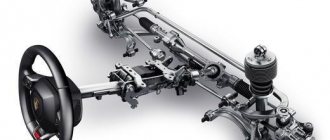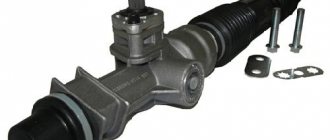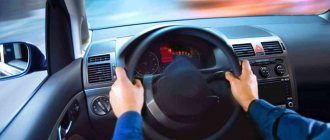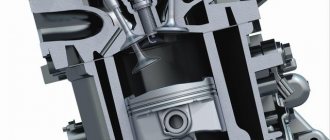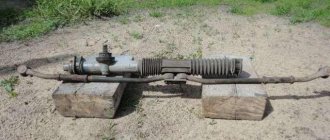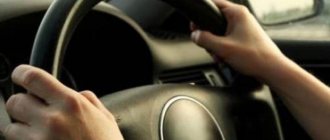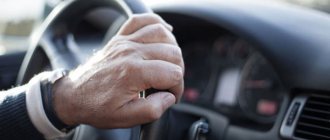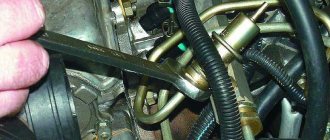Knocking sound when turning the steering wheel indicates that there are problems in the vehicle's steering system. The causes of knocking may be malfunctions of the constant velocity joint (CV joint), ball joint, wear of the steering tip and/or support bearing, stabilizer link and other malfunctions. In any case, when a knock is heard when turning the steering wheel, it is necessary to carry out diagnostics as quickly as possible, since malfunctions of the steering system not only worsen over time, but can also lead to emergency situations when the car is moving, even an accident.
Causes of knocking noise when turning the steering wheel
There are a number of reasons why a knock is heard when turning the steering wheel. To more accurately determine the malfunction, it is necessary to determine three circumstances:
- Sound type. It can be single or repeated, voiceless or voiced (usually metallic), loud or quiet.
- The place from which the sound comes. For example, in the wheel, in the suspension, in the steering wheel.
- Circumstances of occurrence. In particular, when driving, when turning the steering wheel in place, when the steering wheel is turned all the way, when turning left or right.
Based on such data, you can focus on the source of the knocking sound.
| Place of knock | Causes of knocking |
| Knocking in the wheel | Partial failure of the angular velocity joint (the boot is torn, problems with the bearing), noise from tie rods/steering rods, steering rack when driving on rough roads, shock absorber struts (spring knocking), stabilizer struts |
| Rack knock | Damage to the rack shaft, increased play of the bushing and/or shaft bearings, on machines with electric power steering, mechanical damage to the engine shaft and/or worm drive, wear in the steering shaft driveshaft |
| Knocking in the steering wheel | Partial failure of the steering rack, rusting of the rack drive shaft, wear of the worm drive in the EUR and/or mechanical problems with the electric motor |
| Steering wheel position | Causes of knocking |
| When turning the steering wheel all the way (left/right) | When replacing the front control arm, it is possible that the lever hits the subframe when turning. Sometimes craftsmen simply do not fully tighten the fasteners, which cause them to creak when turning. |
| When turning the steering wheel while the car is stationary | Faulty steering rack, universal joint, loose fasteners, tie rods/ends |
| When turning the steering wheel while the car is moving | The same reasons as when the car is stationary, but problems with stabilizer struts and shock absorber struts are added here. |
Below is a list of reasons why knocking occurs when turning in the area of the wheel, suspension and steering wheel, according to the degree of their prevalence.
It's the suspension that makes the sound.
Usually we can talk about this for sure only after diagnosis. At the stage when all that remains is to replace the faulty parts. Otherwise, by trial and error, you can move ad infinitum, and then still find a forgotten glass bottle rolling along the bottom of the front glove compartment, or other numerous exotic cases from repair practice.
Levers and articulations
Each guide vane arm begins and ends with a hinge. They can be rubber-metal (silent blocks) or rigid (ball joints and supports, bearings). As a result of wear, any of them can knock.
In terms of frequency of occurrence, ball joints hold the lead. As the name suggests, they are a spherical tip rotating in a metal housing with nylon liners. The bushings are pressed with springs, the fit is tight, and the new part works without play, that is, it cannot knock. As the balls and bearings wear out, a gap forms, the part gains unintended freedom, and a knock is heard in the suspension on small irregularities.
Diagnostics here consists of applying force in the opposite direction from the joint prestress. This depends on the kinematics of the suspension; sometimes the pin needs to be pulled outward from the body, at least with the help of a mount, but occasionally in the opposite direction. For example, in a MacPherson-type suspension, the lower support works differently than in a classic double wishbone.
Silent blocks usually creak, not knock. But they can also be brought to such a state that all the rubber has already run out, and the blows are metal on metal. One glance is enough to reveal the catastrophic nature of the situation, in which it is often necessary to change the lever assembly.
Stabilizer
There are usually two places on the anti-roll bar where wear can occur. These are bushings for attaching to the body or subframe and struts. The bushings are a collapsible silent block, in which it is enough to replace the rubber elastic element. Although in severe cases such wear forms on the stabilizer bar itself that replacing the bushings is not enough; a new large part will be required.
Stabilizer links are a very weak point on all cars. They experience heavy loads, but are compactly designed
It doesn’t matter how they are designed, on the basis of ball joints or with rubber elements, the assemblies are always changed. Nobody at the factories is going to strengthen them; the parts are simple, inexpensive, can be diagnosed by simply shaking the rack rod, and therefore are considered consumables
Springs and shock absorbers
Knocks can be heard very rarely from the springs. Usually only in case of fatigue failures of the outermost turns. It’s not even always noticeable, but it sounds loud while driving, and the car’s posture changes even more noticeably. The body seems to sit on one side, and often on both, since the springs like to break in pairs. At the same time, you need to replace the cushions on which the spring rests on its upper and lower sides.
Shock absorbers make themselves known much more often. Both by themselves and in places where they are attached. In order of frequency of occurrence, several sources can be identified that cause knocking in the front suspension on small bumps:
- the upper supports of the front struts in the MacPherson suspension, where the bearings and rubber couplings are destroyed;
- lower and upper silent blocks of shock absorbers of classic suspension on A-shaped triangular arms;
- internal failures in the shock absorbers themselves.
Diagnosis is usually carried out by touching the suspicious area with your hand while rocking the front of the car. Play in the upper supports, knocks inside the shock absorber or wear on the rubber elements are clearly visible. Moreover, all this is not noticed immediately, the car manages to drive in a faulty state, and the sounds are accompanied by visual effects, oily sweating of the bodies, sticking out of the body from the body higher than usual, or rubber rags coming out of the silent block clips. Racks, like supports, are usually replaced as an assembly; it is illogical to leave rusty and tired metal, even if it is not yet broken.
Constant-velocity joint
With the wheels turned completely to one side, the CV joint will most often creak (it may even give impacts to the steering wheel). When turning the car to the left, the right outer CV joint will crunch/knock, and when turning to the right, the left one will, accordingly. Inner CV joints usually creak when driving at high speed on uneven roads, so they have nothing to do with knocking when turning. So if you hear a knocking sound when turning or sharply accelerating your car, the outer joint most likely needs to be replaced. However, first you can remove it and inspect it - if there is no wear or it is small, then CV joint lubrication will help.
Tie rods and tie rods
Due to natural wear and tear, the lugs and rods may, over time, become loose and squeak and make knocking noises when turning the machine. To diagnose the steering tips, you need to jack up the car on the side where the annoying sound is coming from and first remove the wheel. Next, you need to shake the rods and tips and check for any play in them. It often happens that the boot on the tip breaks, which means dirt and moisture gets inside. This causes a corresponding knock.
There are cases when, for example, when performing a wheel alignment operation, a car enthusiast or master forgets to tighten the fastening nut between the steering rod and the steering tip. Accordingly, when you turn the steering wheel, both in motion and at a standstill, a loud metallic knock will be heard. You can determine more precisely if you shake the front wheel left and right with your hands, it will dangle and make similar sounds.
Quick Guide
The main reason for tapping is the formation of a gap in the joints. In the steering system, there may be knocking on the tips, ball joints of the rods, the rack, the “cardan” in the column, the steering wheel on the shaft, or the auto-folding system in case of an accident. The metallic sound is distinct and can be heard in place when rocking the steering wheel.
It is quite possible to mistake problems in the suspension for problems in the steering, since the initial stages of wear of bearings and supports only make themselves felt when cornering at speed. In the suspension part, the cause of the knock should be sought in the wheel bearings, ball joints and “supports”.
A knocking sound when turning the steering wheel indicates problems with the vehicle's steering system. The causes of knocking may be malfunctions of the constant velocity joint (CV joint), ball joint, wear of the steering tip and/or support bearing, stabilizer link and other malfunctions. In any case, when a knock is heard when turning the steering wheel, it is necessary to carry out diagnostics as quickly as possible, since malfunctions of the steering system not only worsen over time, but can also lead to emergency situations when the car is moving, even an accident.
Steering rack
Steering rack malfunctions are one of the most common causes of knocking noise when turning wheels. Moreover, this can happen both while moving and when turning the steering wheel in place. There are several reasons why a car's steering rack may knock:
- Loose steering fasteners.
- The plastic support sleeve has failed (considerably worn out, play has appeared).
- The occurrence of play in the rack shaft bearings.
- Increased gap between the teeth of the steering rack (this leads to both play and a dull knock when the steering wheel rotates in place).
- The anti-friction gasket wears out, causing the clamping “cracker” to vibrate, knocking directly on the rack body.
It is not easy to understand that it is the steering rack that is knocking and not another element of the steering mechanism. To do this, you need to turn off the engine, put the car on the handbrake, and ask your partner to take the wheel. And climb under the car yourself at the location of the steering rack. When you rotate the steering wheel with a faulty rack, creaking (crunching) sounds will come from it.
Steering cardan
If, when turning the steering wheel, you hear a knocking sound from the steering column, then the steering wheel shaft driveshaft is most likely to blame. Very often UAZ owners face this problem. A malfunction occurs due to an increase in the gap in the spline joint. On VAZs, a knocking sound from the steering column occurs due to a broken universal joint. It can be heard both while driving and when turning the steering wheel back and forth in place.
You can check it with your hand - you need to hold the universal joint with one hand, and turn the steering wheel with the other; if it is loose, then repair is needed.
Many owners of domestic front-wheel drive VAZs - “Kalinas”, “Priors”, “Grants” - are faced with the fact that over time the crosspiece in the driveshaft begins to creak. Its diagnosis is carried out according to the procedure described above. If play and creaking are detected, the car owner can choose one of two options. The first is to buy a new cardan, the second is to try to repair the installed one.
Moreover, they are repaired not because of the high price, but because of a large number of defective new cardan shafts. In particular, we are talking about the fact that the cardan can “bite”. This is caused by the fact that its half with splines moves with jamming, and jerks are already felt in the new part. Accordingly, when purchasing a new crosspiece, you need to make sure that it moves freely in all directions. It often happens that in a fork with splines, the bearings are initially skewed due to misalignment of the holes. Therefore, it is up to the car owner to decide whether to buy a new cardan or not.
Another way out of the situation is to replace the existing needle bearings in the cardan crosspiece with caprolactane bushings. This option is supported by the fact that many taxi drivers who own VAZs, due to the fact that they have to turn the steering wheel a lot, do exactly this.
This option implies the complexity of repair work. As for dismantling, they usually use 13mm wrenches and a flat-head screwdriver.
Please note that in order to knock out the bearings it is necessary to strike the base of the fork under the bearing. You need to hit it carefully with a small hammer.
On the Internet you can find many conflicting reviews about various cardan shafts and bushings. For VAZ “Kalina”, “Priora”, “Granta” cars, crosspieces of the “CC20” and “TAYA” brands are often installed, or a more expensive option is Japanese spare parts Toyo and GMB.
Let's sum it up
It is worth using various methods to test equipment before replacing. Otherwise, because of one knock, you can change half of the suspension without eliminating the cause of the problem. Therefore, you should always approach diagnostics from different angles and use the services of testing suspension parts at several service stations. You can change parts only if you are sure that certain mechanisms are faulty. You should approach the issue of repair with full understanding so as not to spend too much money on this process. Many novice drivers simply buy every part that they are guilty of, and as a result, repairs are very expensive.
There are certain difficulties in diagnosing the chassis of a modern car. It is not at all clear which element may be causing the knocking. There are a number of possible options, they are all interconnected, and even analysis does not answer the question. Therefore, it is very difficult to use the full picture of the breakdown to purchase the spare parts necessary for repair. Sometimes you have to change parts just at random, not getting the result on the first try. There are various repair options available, but to do so you need to pinpoint the problem. How do you usually diagnose and repair the chassis of your car?
Shock absorber struts and/or support bearings
If the cause of the knocking lies in the shock absorbers or support bearings, then there will be knocking not only when turning the steering wheel to the right/left, but also when driving in a straight line. However, during sharp turns, especially at high speed, such a knock will be more pronounced, since additional loads will be applied to the shock absorbers and bearings.
In the latter case, the cause of the knock may be a broken shock absorber spring. This usually happens at its edges (top or bottom). Accordingly, when driving on uneven roads, as well as when the car rolls in turns, the driver may hear a metallic clanging sound. When turning left - right spring, when turning right - left spring.
You can check the shock absorbers and bearings by examining them for play. To do this, you need to dismantle the wheel and shake/twist the shock absorbers and bearings. In rare cases, the knocking noise may be caused by a loose fastening nut.
Front stabilizer
If the stabilizer link partially fails, a dull knock is heard when the wheels turn while moving. Moreover, the wheels begin to knock if they are turned to one side or the other at approximately 50...60%. However, a faulty strut itself can creak not only when turning, but also when the car is moving on an uneven road. Often the car also “fidgets” on the road, that is, it is necessary to constantly control (twist) the steering wheel. Additional signs - the car body rolls too much when entering a turn and sways when braking.
Subframe (atypical situations)
Sometimes atypical situations that are quite difficult to diagnose lead to knocking when turning. For example, there is a known case when, while the car was moving, a small stone hit the subframe and got stuck there. When you turn the steering wheel in one direction or the other, a natural displacement of the steering gear elements occurs, and they seem to run over this stone. When the elements were restored to their original position, they jumped off the stone, making a characteristic sound. The problem was solved by removing the stone.
When repairing suspension elements, for example, when replacing the front arm, the latter may touch the subframe when turning the wheel. Naturally, this is accompanied by a blow and a grinding sound. To get rid of it, it was enough to lift the subframe using a pry bar.
If you frequently drive on poorly paved roads, it is useful to periodically inspect the suspension and steering components. This will allow you to diagnose a breakdown at an early stage, and therefore save on subsequent repairs.
Another atypical situation of knocking in the suspension when turning is that the subframe bolt loosens, and the subframe itself can knock when driving, and even more so when turning. It can be eliminated by tightening the corresponding bolt.
Checking all noises
To avoid problems in the future, it is necessary to monitor the condition of the machine from time to time. Every 2-3 months you need to inspect the car on a lift. Metal structures and threaded connections require great attention. Along with them, it is worth inspecting the wheels with fastening joints. Most often, crackling and clicking noises occur in cars made by domestic manufacturers. After visual diagnostics, it is worth tightening the nuts and bolts, as well as bringing loose structures to their original condition. Only in this case the car will not make strange sounds, but, on the contrary, will serve faithfully for a single year.
As for preventive measures, you should not neglect them. First of all, the driver must regularly lubricate the mechanisms, not forgetting to check the anthers and protective elements. There is also no need to practice an aggressive riding style. It negatively affects the condition of the chassis. Smooth braking and avoiding potholes whenever possible are the best methods of prevention. In addition to this, it is worth stopping near the curb. When entering a parking space, the driver should not hit it. The wheels receive a strong blow, and all the force is directed to the steering elements.
